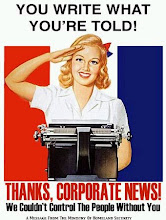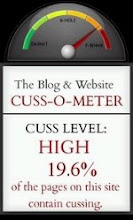No wonder mainstream media are goin down;...
Sun May 17, 2009 9:05 pm (PDT)
http://maruthecrankpot.blogspot.com/2009/05/no-wonder-print-media-is-going-down.html
http://www.middle-east-online.com/english/?id=32027
First Published 2009-05-13
Media Wink at Torture
Even as the power balance has shifted - and many readers have dumped their subscriptions - the Washington Post has chosen to remain a neocon bastion, turning its op-ed page into something of a clearinghouse for the excuses from all the ex-President´s men, says Robert Parry.
These days, the Washington Post has the look of one of those Southern newspapers in the 1960s standing firm for segregation as the wave of civil rights swept across the region. Except for the Post, the blind commitment is to neoconservatism.
The Post editors probably believe they are upholding some twisted journalistic principle, defying the views of most readers in a city that has a large African-American population, voted overwhelmingly for Barack Obama, and shows little sympathy for the neocons who rode roughshod over so many when George W. Bush was in power.
Even as the power balance has shifted - and many readers have dumped their subscriptions - the Post has chosen to remain a neocon bastion, turning its op-ed page into something of a clearinghouse for the excuses from all the ex-President´s men.
It also remains a comfortable home for pundits who pushed the Iraq War and seem to get a kick out of Muslims getting stripped naked and waterboarded.
The latest Post columnist to weigh in sympathetically on torturing Muslims labeled "unlawful enemy combatants" by the Bush administration is Richard Cohen in a classically dimwitted column entitled "What If Cheney´s Right?"
Cohen argues that former Vice President Dick Cheney had a point when he asserted that "enhanced interrogation techniques," including the near-drowning experience of waterboarding, elicited important intelligence information from the suspects and thus saved American lives.
Cohen, who apparently considers himself quite clever and the issue of torture rather funny, starts the column off with the quip, "Blogger Alert: I have written a column in defense of Dick Cheney." He later adds about the torture debate, "this is not merely some political catfight conducted by bloggers."
While agreeing that torture is morally wrong, Cohen writes that "where I reserve a soupçon of doubt is over the question of whether `enhanced interrogation techniques´ actually work. That they do not is a matter of absolute conviction among those on the political left, who seem to think that the CIA tortured suspected terrorists just for the hell of it."
Cohen apparently views himself as much more of a free-thinker than "those on the political left." He notes that Cheney - through his declaration that critical intelligence was extracted by these means - "poses a hard, hard question: Is it more immoral to torture than it is to fail to prevent the deaths of thousands?"
Bogus Intelligence
However, Cohen regrets that Cheney´s credibility is lacking due to his pre-Iraq War claims, such as when Cheney "insisted that `the evidence is overwhelming´ that al-Qaeda had been in high-level contact with Saddam Hussein´s regime when the `evidence´ was virtually non-existent."
If you were expecting that the next paragraph would observe that Cheney´s "evidence" for Hussein´s contact with al-Qaeda was based on a coerced confession from one of the CIA´s "high-value detainees," Ibu al-Sheikh al-Libi, you would be disappointed.
Though al-Libi´s case is precisely on point - and he is in the news since he reportedly just died (a purported suicide) at a Libyan prison - Cohen doesn´t mention al-Libi, who concocted those stories about Hussein assisting al-Qaeda to escape torture.
Al-Libi´s false claims had horrendous consequences, including the loss of much more life than occurred on 9/11.
A June 2002 CIA report cited claims by al-Libi that Iraq had "provided" unspecified chemical and biological weapons training for two al-Qaeda operatives. Al-Libi´s information also was inserted into a November 2002 National Intelligence Estimate.
Al-Libi´s claim found its way into Vice President Cheney´s public presentations and into then-Secretary of State Colin Powell´s infamous speech to the United Nations on Feb. 5, 2003.
But the Bush administration´s confidence about al-Libi´s information went against the suspicions voiced by the Defense Intelligence Agency. "He lacks specific details" about the supposed training, the DIA observed. "It is possible he does not know any further details; it is more likely this individual is intentionally misleading the debriefers."
The DIA´s doubts proved prescient. In January 2004 - nearly a year after the United States invaded Iraq - al-Libi recanted his statements and claimed that he had lied because of both actual and anticipated abuse, including threats that he would be sent to an intelligence service where he expected to be tortured.
Al-Libi said he fabricated "all information regarding al-Qa´ida´s sending representatives to Iraq to try to obtain WMD assistance," according to a Feb. 4, 2004, CIA operational cable. "Once al-Libi started fabricating information, [he claimed] his treatment improved and he experienced no further physical pressures from the Americans."
Despite his cooperation, al-Libi said he was transferred to another country that subjected him to beatings and confinement in a "small box" for about 17 hours. He said he then made up another story about three al-Qaeda operatives going to Iraq "to learn about nuclear weapons." Afterwards, he said his treatment improved. [For details, see our book, Neck Deep.]
Lost Lives
Al-Libi´s false confessions contributed to the deaths of hundreds of thousands of Iraqis and more than 4,200 American soldiers who have died in Iraq. Though such a point would appear crucial in evaluating the moral conundrum that the Post´s Cohen posed - regarding torture and saving lives - Cohen leaves it out and no Post editor put it in.
Besides the unreliability of tortured confessions, abusive treatment of detainees has stirred anti-Americanism and contributed to the death toll of American troops in Iraq, according to US military officers.
Former Navy general counsel Alberto Mora told the Senate Armed Services Committee in June 2008, "there are serving US flag-rank officers who maintain that the first and second identifiable causes of US combat deaths in Iraq - as judged by their effectiveness in recruiting insurgent fighters into combat - are, respectively the symbols of Abu Ghraib and Guantanamo."
Having ignored these crucial points - reliability of intelligence and recruiting of new terrorists - Cohen goes on to praise Cheney´s eagerness to have a full and open debate on torture. "He is right about that," Cohen writes of Cheney.
Amazingly, however, Cohen defends Cheney´s position by citing the lack of a robust debate prior to the Iraq War.
"The run-up to the disastrous Iraq war was notable for its smothering lack of debate," Cohen writes. "That served us poorly then and it would serve us poorly now if people who know something about the utility, not to mention the morality, of enhanced interrogation techniques keep their mouths shut."
Perhaps Cohen thinks he is cleverly hoisting Iraq War critics on their own petard, but he is ignoring the role that Cheney, the Post and indeed his own columns played in silencing that dissent.
In the months before Bush´s invasion of Iraq, the Post editorial and op-ed pages were packed with a neocon consensus about the justifications for war and only ridicule for those who raised doubts.
For instance, in September 2002, when former Vice President Al Gore objected to the rush to war, Post columnists distorted and mocked what Gore had said.
Michael Kelly called Gore´s speech "dishonest, cheap, low" before labeling it "wretched. It was vile. It was contemptible." Charles Krauthammer added that the speech was "a series of cheap shots strung together without logic or coherence." There was no countervailing opinion published.
After Powell´s UN speech, the Post judged the presentation "irrefutable," adding: "it is hard to imagine how anyone could doubt that Iraq possesses weapons of mass destruction." That judgment was reinforced by a phalanx of Post columnists, including Richard Cohen, all hailing Powell´s speech.
Cohen laughed at anyone who still doubted that Saddam Hussein possessed hidden WMD stockpiles.
"The evidence he [Powell] presented to the United Nations - some of it circumstantial, some of it absolutely bone-chilling in its detail - had to prove to anyone that Iraq not only hasn´t accounted for its weapons of mass destruction but without a doubt still retains them," Cohen wrote. "Only a fool - or possibly a Frenchman - could conclude otherwise."
After the US invasion of Iraq and the failure to discover the imaginary WMD stockpiles, Post editorial-page editor Fred Hiatt made a rare and grudging apology. Hiatt acknowledged that the Post should have been more skeptical.
"If you look at the editorials we write running up [to the war], we state as flat fact that he [Hussein] has weapons of mass destruction," Hiatt said in an interview with the Columbia Journalism Review. "If that´s not true, it would have been better not to say it." [CJR, March/April 2004]
Nevertheless, the Post´s editorial pages continued to attack American citizens who dared challenge Bush´s case for war, such as the Post´s assaults on former US Ambassador Joseph Wilson whose criticism led the Bush administration to expose Wilson´s wife, Valerie Plame, as a covert CIA officer. [See Consortiumnews.com´s "WPost Is a Neocon Propaganda Sheet."]
Cohen´s Obtuse Record
On the Plame case, Cohen also took up the neocon banner, defending Cheney´s former chief of staff, Lewis Libby, who was convicted of obstruction of justice and perjury in connection with Plame´s outing. Cohen joined an Inside-the-Beltway pundit riot against Libby´s 30-month jail sentence and helped build up support for Bush´s decision to commute Libby´s sentence, sparing him jail time.
Cohen called the Libby case "a mountain out of a molehill" and poked fun at Americans who thought the invasion of Iraq might have been a bad idea.
"They thought - if `thought´ can be used in this context - that if the thread was pulled on who had leaked the identity of Valerie Plame to [columnist] Robert D. Novak, the effort to snooker an entire nation into war would unravel and this would show . . . who knows? Something," Cohen wrote.
That Cohen was wrong about WMD and the case for war in Iraq should not have come as a surprise. His cluelessness is almost legendary. On nearly every major development of the past couple of decades, Cohen has missed the point or gotten it dead wrong.
For example, during the Florida recount battle in 2000, Cohen cared less about whom the voters wanted in the White House than the Washington insiders' certainty that George W. Bush would be a uniter, not a divider.
"The nation will be in dire need of a conciliator, a likable guy who will make things better and not worse," Cohen wrote. "That man is not Al Gore. That man is George W. Bush." [For more, see Consortiumnews.com´s "Is WP´s Cohen the Dumbest Columnist?"]
Perhaps even more troubling than the Post's stupidity, however, is the racism that seems to underlie the smirking attitude within the Post´s editorial offices about the humiliation, torture and slaughter of Arabs and other Muslims.
Do Richard Cohen and his editors think it´s funny that Cheney and Bush saw nothing wrong with subjecting Muslim detainees to forced nudity (often in front of women), to days on end of sleep deprivation, to confinement in painful stress positions and to waterboarding?
If not, why the snotty tone of Cohen's column? "Blogger Alert"; "political catfight conducted by bloggers"; "soupçon of doubt"?
It is hard to imagine if the victims of the torture and abuse were of any other racial, religious or ethnic group that such a lighthearted tone would be acceptable. But anti-Muslim racism appears to be part of the Post´s editorial mindset, reflected in a similar lack of outrage over civilian deaths during Israel´s 2006 war in Lebanon and the 2008-09 assault on Gaza.
As the Post faces today´s economic crisis amid talk that it may not survive as a going-concern, the newspaper may look for sympathy from the community that it purports to serve. But the Post´s endless excuses for the crimes of the Bush administration have left many readers with an ambivalent sense of whether the Post deserves to survive.
Even some journalists privately feel such disgust at the Post´s neocon positioning that they tell me that if they woke up tomorrow and the Post had ceased to exist, they wouldn´t shed a tear.
Robert Parry broke many of the Iran-Contra stories in the 1980s for the Associated Press and Newsweek. His latest book, Neck Deep: The Disastrous Presidency of George W. Bush , can be ordered at neckdeepbook.com. His two previous books, Secrecy & Privilege: The Rise of the Bush Dynasty from Watergate to Iraq and Lost History: Contras, Cocaine, the Press & 'Project Truth' are also available there. Or go to Amazon.com.
ConsortiumNews












